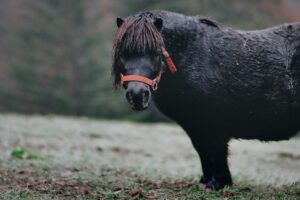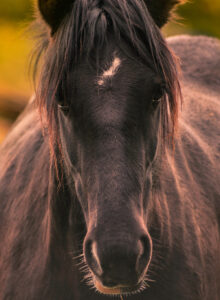Horses are perhaps not the first animals that come to mind when we talk about pet and companion animal obesity. However, if you take the UK as an example, between 31 and 54% of all horses are affected, making obesity one of the most prevalent welfare issues affecting horses.
In the past, horses have been mainly kept for use in transport (ridden and draught), farm work, general labour (cabs, mines) and war. In western countries, when horses as a workforce were replaced with motorized vehicles, the status of the horse changed to ‘sport’ and ‘leisure’ animals. For horse welfare this was generally a step up, horses received more attention and care, and the work was less strenuous than the farm work. However, whereas in the past horses were physically active most of the time, in current times physical activity and exercise is often limited in the daily care regime.
Due  to a reduction in exercise and an increase in the amount and quality of food, an increasingly large section of the horse population is starting to suffer from being obese or at least overweight. Obesity is especially important to avoid in donkeys as they are prone to hyperlipaemia, a disease caused by too much fat in the blood, which can be fatal.
to a reduction in exercise and an increase in the amount and quality of food, an increasingly large section of the horse population is starting to suffer from being obese or at least overweight. Obesity is especially important to avoid in donkeys as they are prone to hyperlipaemia, a disease caused by too much fat in the blood, which can be fatal.
Many horses in western countries spend most of their time indoors within a stable or outdoors but in very small paddocks, where their movement space is severely limited. Within such management systems, there are not many opportunities where horses can move and interact with other horses. When horses are allowed outside, they are often given access to a grassy area, which although providing opportunity to move and graze, means that, unless they own the land and can control access, owners often have little control over the quantity and quality of food consumed and indeed the motivation to monitor such resources.
Most leisure and sports horse owners are extremely dedicated when it comes to the care for their horse. They keep a close watch on various aspects of their lives and spend a lot of time nurturing and grooming their animals to develop and maintain a good bond. Dr Tamzin Furtado discovered in her research that many horse owners prioritise these activities over exercise. Dr Furtado found horse owners to be concerned about their animal being too skinny but often perceived a horse that was overweight as looking healthy. This resulted in many owners being unaware that their horse was suffering due to issues caused by being overweight, until the animal started showing problems.
As is also the case with the owners of dogs, cats and rabbits (as reported in the PDSA’s PAW report 2020), horse owners seem to have an incorrect perception about what a healthy horse looks like regarding his/her weight. They perceive an animal that has too much body fat as a healthy animal that is well cared for. This is a difficult problem to tackle because when a horse looks skinny even though he/she might have the correct weight, owners feel they are not caring for their animal properly. In some cases, it is also possible that weight gain happens in such a gradual manner that owners are not aware that their horses are putting on weight until it is too late – the animal is overweight, and that excess weight is difficult to lose.

Horse owners also struggle to keep to a diet plan for their animals because restricting access to food has potential welfare challenges associated with it. For example, keeping animals stabled to restrict access to lush grass has welfare disadvantages of removing the opportunity for the horse to interact with other animals, and to move around. It is essential for owners to understand that keeping their horses a healthy weight is just as important as other elements of their care, and that there are practical ways that will enable a restricted diet and time outside, exercising and grazing. The Equine Weight Management Guide is a user-friendly resource that helps owners to come up with a plan that fits their individual context – and applies human behaviour change science in the way it is designed too!
In many cases, it is up to practitioners to inform people about their horses’ weight problem. Given that veterinarians see most of their clients only sporadically, it would be useful to provide other practitioners, people that visit horses on a more regular basis, with the tools to initiate dialogue with owners about their animals’ weight and diet. Such professionals include farriers, instructors, trainers, physiotherapists and other professionals – all of whom also recognise the important of animals being a healthy weight; the farrier seeking to avoid the horse getting laminitis; the physio to avoid the negative physiological effects of excess weight; the instructor needing a horse that is able to perform through being fit and healthy. Note that these individuals wouldn’t be providing nutritional advice but rather would broach any concerns they have and signpost their clients to appropriate professional input if needed. Human Behaviour Change for Animals (HBCA) has developed a course targeted at providing frontline practitioners with the tools to effectively communicate with animal owners about obesity and assist them with the development of an action plan to improve the situation. When people can identify weight increase and unhealthy weight in their horses, they are able to develop a plan of action with assistance and support from a practitioner, suited to their horse and their horses’ housing situation.
One of the lead facilitators of this course is Dr Tamzin Furtado who is specialised in the field and has designed well received behaviour change campaigns around equine obesity. If you are interested to learn more about the course or participate click here. Most of the information in this blog comes from two studies from 2019 and 2020 written by Dr Tamzin Furtado.
Author: Anouk de Plaa

